Attack Of The Balloon Men
The Ambitious Folly Of Transformers: Pretenders
I used to have a line. I’ve always understood that buying too many toy robots was perhaps not the healthiest (or most financially-sound) of pursuits, but so long as I was genuinely enjoying them, was there any real harm? The key was to not cross into buying them for the sake of it - knowingly acquiring poor ‘bots (or which otherwise did not speak to my tastes) just to fill holes in the collection.
And that meant staying well away from Pretenders - the 1988/89 sub-line of Transformers which hid extremely basic shape-changing robots inside dumpy, sarcophagus-like action figure shells. They marked my point of departure from badgering my parents for Transformers as a kid, and their market stall bootleg look means I couldn’t employ my usual ‘fascinating retro-futurist aesthetic from Japan’ excuses for collecting toys today. No Pretenders: that was the line.
Oops.
Pretenders have always been a polarising aspect of vintage Transformers. There are plenty who embrace them, taking the position that any 80s Transformer is necessarily A Good Transformer. There are plenty who vilify them, feeling they’re a desperate misstep that abandoned too much of the toyline’s core robot/vehicle appeal. And there are a few perhaps less ideological souls, including myself, who fall somewhere in the middle.
Conceptually, Pretenders make a lot of sense - though less so for the poor comics and cartoon writers who had to try and explain why the latest batch of Autobots and Decepticons were hiding inside bulbous skinsuits designed after assorted space marines and aliens. But this is a line about ‘robots in disguise’, so dressing up as anything other than a robot surely counts as disguise, whether or not it’s logical and/or remotely convincing. Case in point:
Hmm.
However, context is king here. In 1988, Transformers was, though not yet dying, very much losing. The age of more ‘pure’ sci-fi toys centred around robots and spaceships - a legacy in some ways of late 70s/early 80s sci-fi movies - was waning fast. Instead, the big toys of the age were more fantastical, lurid - and humanoid. Thundercats had come and mostly gone by then, The Real Ghostbusters was ascendant - and most of all in 88 and 89, Teenage Mutant Ninja Turtles had a chokehold on boys’ imaginations.
Pretenders were a pivot to try and keep up with the action figure Joneses, which makes all the sense in the world on paper: toys are about sales, not some design purity, and sales means going where the audience does. But they also mark the point where Transformers became reactive rather than proactive in the market, and I do wonder if kids could smell the desperation.
But there’s more to it than that. To put things simplistically, why weren’t Pretenders better? How did we end up with a range of startled-looking egg-men with darts player physiques in a line designed to compete with the highly-stylised Turtles et al?
It’s not my place to say, though it’s easy to speculate that it’s down to the toys’ Japanese designers at Takara not being either as versed in or as impressed by the Schwarzenneger and Stallone power fantasy physiques dominating the US and European box office. Or simply that this was a company accustomed to making intricate but boxy robot and vehicle toys, not musclebound action dolls. But the net result was that if you offered an eight-year-old kid this:
… or this:
…then it probably wasn’t much of a choice at all.
Most Pretenders had no articulation other than arms which waggled stiffly at the shoulders, which made a rival toy with a 360-degree neck and Real Kung Fu Kick action at the hips seem like a minor miracle by comparison.
Moreover, a Turtle or Thundercat - even a by-then forgotten He-Man - was all ready-for-action splayed limbs and murderous expressions in its stock pose. Whereas Pretenders stood stiffly and inert, like bored businessmen riding an elevator to the 18th floor on a rainy Tuesday morning. As fun as the idea was, the execution didn’t exactly encourage daydreaming about apocalyptic sci-fi war.
Furthermore, thanks to a likely combination of budgetary restrictions and then-limited toy tech, the robots inside the Balloon Men were skeleton-thin and fairly homogenous. They were then scrunched up into awkward corpse-like poses, so that the two parts of the Pretender shell would close over them.
Their transformation then basically entailed folding upon themselves at the waist (in a manner which unfortunately evokes that apocryphal story about Prince), to result in something which sort of maybe kinda looks like a car or spaceship or speedboat, if you squint a bit and willingly lie to yourself.
They’re not awful: I want to be clear on that. Add in a few weapons which either attach to the ‘vehicle’ or can be wielded by the Balloon Man, plus in many cases a removable hat and belt, and you have yourself a little playset. A kid could keep themselves busy popping the Pretender in out of its shell and near-instantly flipping the robot between its two underwhelming modes.
And the monstrous Decepticon designs, taking kaiju cues to create a spread of blunt-spiked horrors, were a whole lot more fun (not to mention closer to what other toylines were doing) than the assorted anxious-looking oil rig workers and scuba divers who made up the Autobot Pretender legions.
Plus - the most dangerous thought of all for a would-be collector of these damned things - Pretenders are a whole lot better en masse than singly. Complementary colours and interchangeable acessories - in some cases even being able to swap the inner robots - were a springboard to fun.
Trying to imagine superheroic bust-ups with just one of these awkward blimp-people was a much taller order - which meant your average kid probably never asked for a second after receiving one for their birthday. They’re not awful - but they’re simply not good enough, as either a transformer or a lurid action figure.
An exception is the Pretender Beasts, which eschewed all articulation in their animalistic shells, but had the advantage of looking like something you could well imagine tearing your face off. A memorable UK comics presence for a couple of them also gives them more resonance than they might otherwise deserve.
To their credit, Pretenders also broadly improved in their second and final year. The shells shrunk somewhat, with generally trimmer waistlines to boot, while the inner bots shrank even more, now only filling a fraction of their egg-like man-coffin.
Despite being Short Kings, they were proportionally a great deal more like a traditional Transformer, and generally morphed into basic but significantly more convincing alternate modes, ranging from tanks to crabs - and ones which were far less dependent on pretending you couldn’t see their heads jammed into their own arseholes.
Meanwhile, the higher-end Pretenders even saw their outer shells transform too, and in some cases even combine with their tiny innies. These blobby blighters felt a lot more like Actual Transformers, as opposed to an underwhelming Transformer stuffed inside an underwhelming action figure.
But despite some great efforts such as Thunderwing (pictured above), sadly some of these were the most silly-looking Pretenders, such as the abominable Vroom here:
Yes, this Balloon Man turns into a functional motorcycle, with the innie as its sidecar, but he also looks like a misjudged dildo with a face, whose expression screams profound existential horror.
In short, despite some giant improvements, the second year of Pretenders would be their last, and the line then switched to chasing a different trend (the teeny-teeny vehicle range known as Micro Machines - Micromasters was Transformers’ riposte).
It’s telling that, across the 35 years since, Hasbro has never truly tried to do Pretenders again (despite some partial homages). Is it because they still haven’t figured out how to do the concept justice, i.e. a proper Transformer inside a fully-articulated shell? Or is it because it’s a wound that never quite healed?
As for me, this year I helplessly ended up with a shelf full of Pretenders, after having collected most everything that came before them. Finding my dopamine fix any way I could. Fortunately, I managed to stop myself from getting all of them - most especially the six US-exclusive 1988 ones, which command absurd prices - by listening to my withered heart. (And let’s not get started on the vanishingly rare end-of-line Japanese ones, which sell for thousands complete).
As much as I appreciate what the designers were trying to achieve, and the context within which they did, I just can’t pretend I have a great time with these things. The tactile stimulation and aesthetic curiosity most vintage toy robots give me simply isn’t there with a rotund plastic man in a hat. I have no issue with Pretenders’ existence - but the execution was a toy that didn’t turn my head in 1988, and one which really only does so from a grim, lizard-brain urge towards completionism now.
On the other hand, I would give my life for Depressed Walrus Guy, aka Longtooth, here.


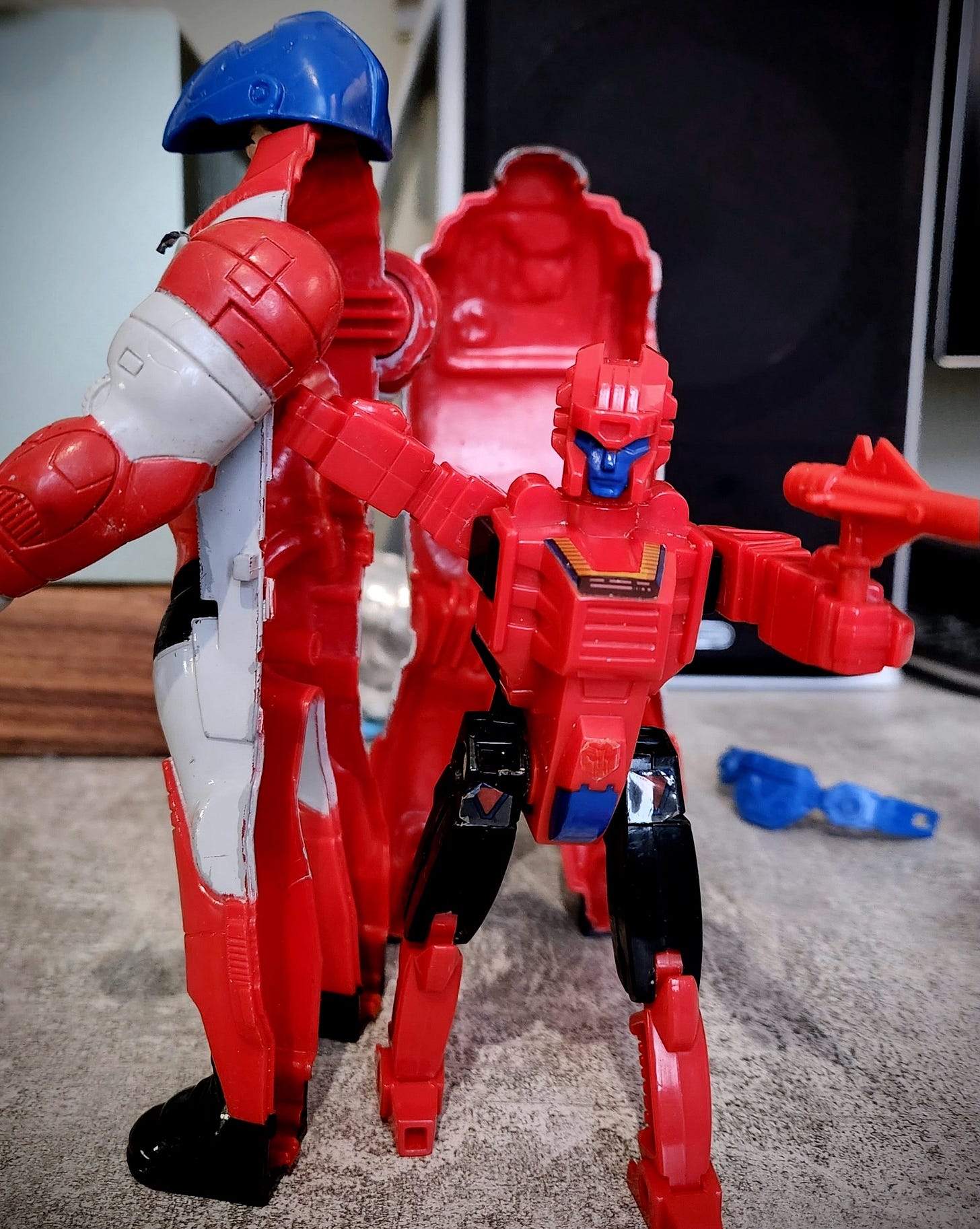




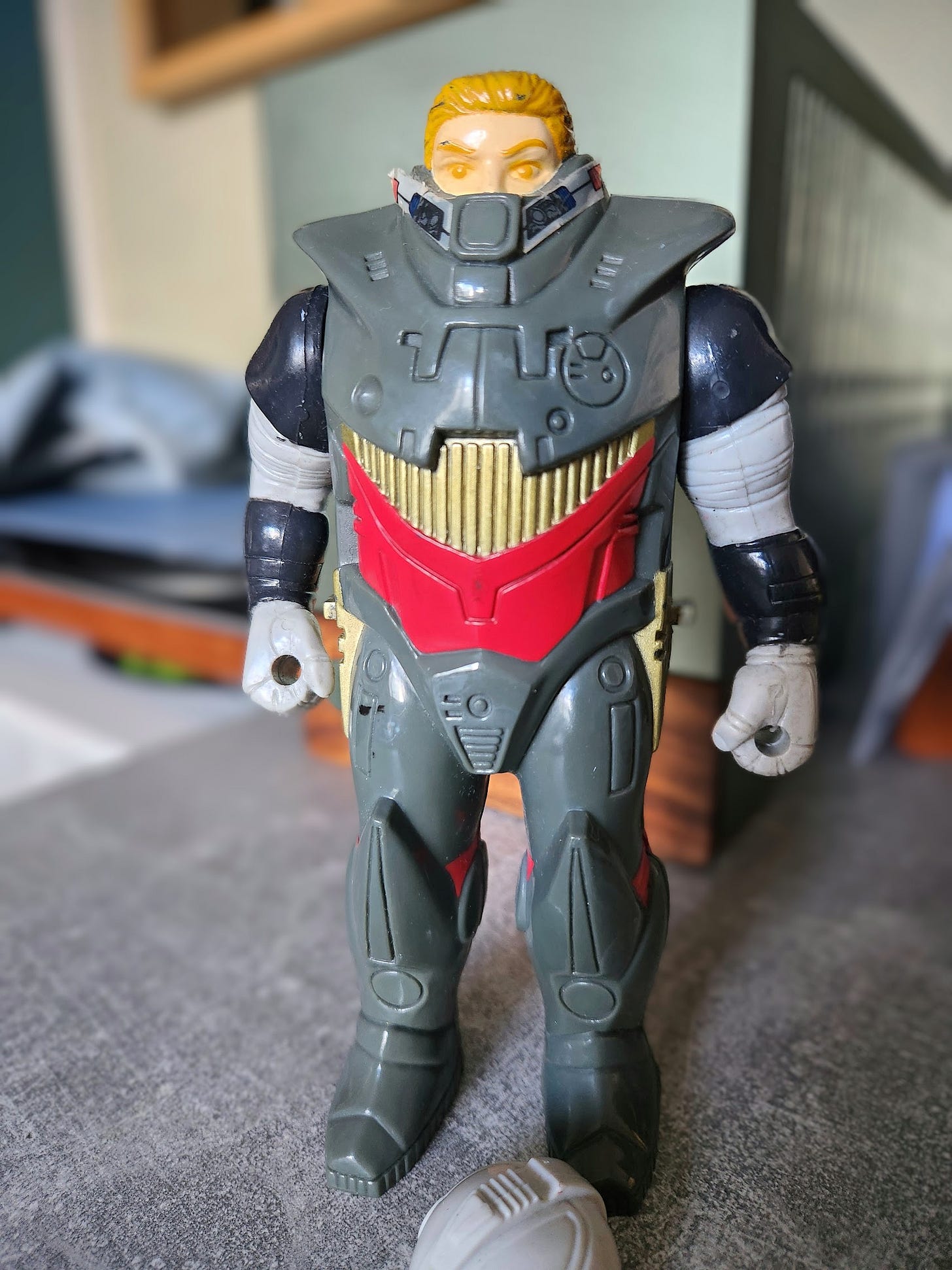


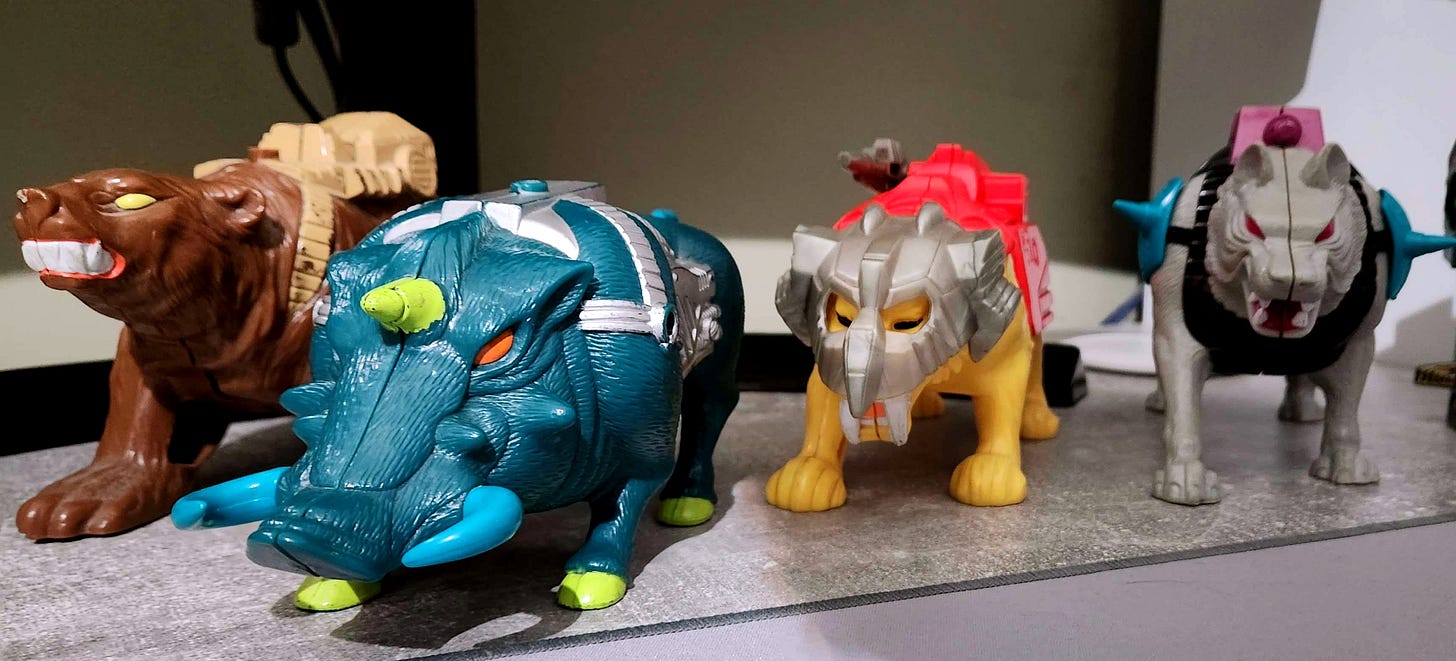
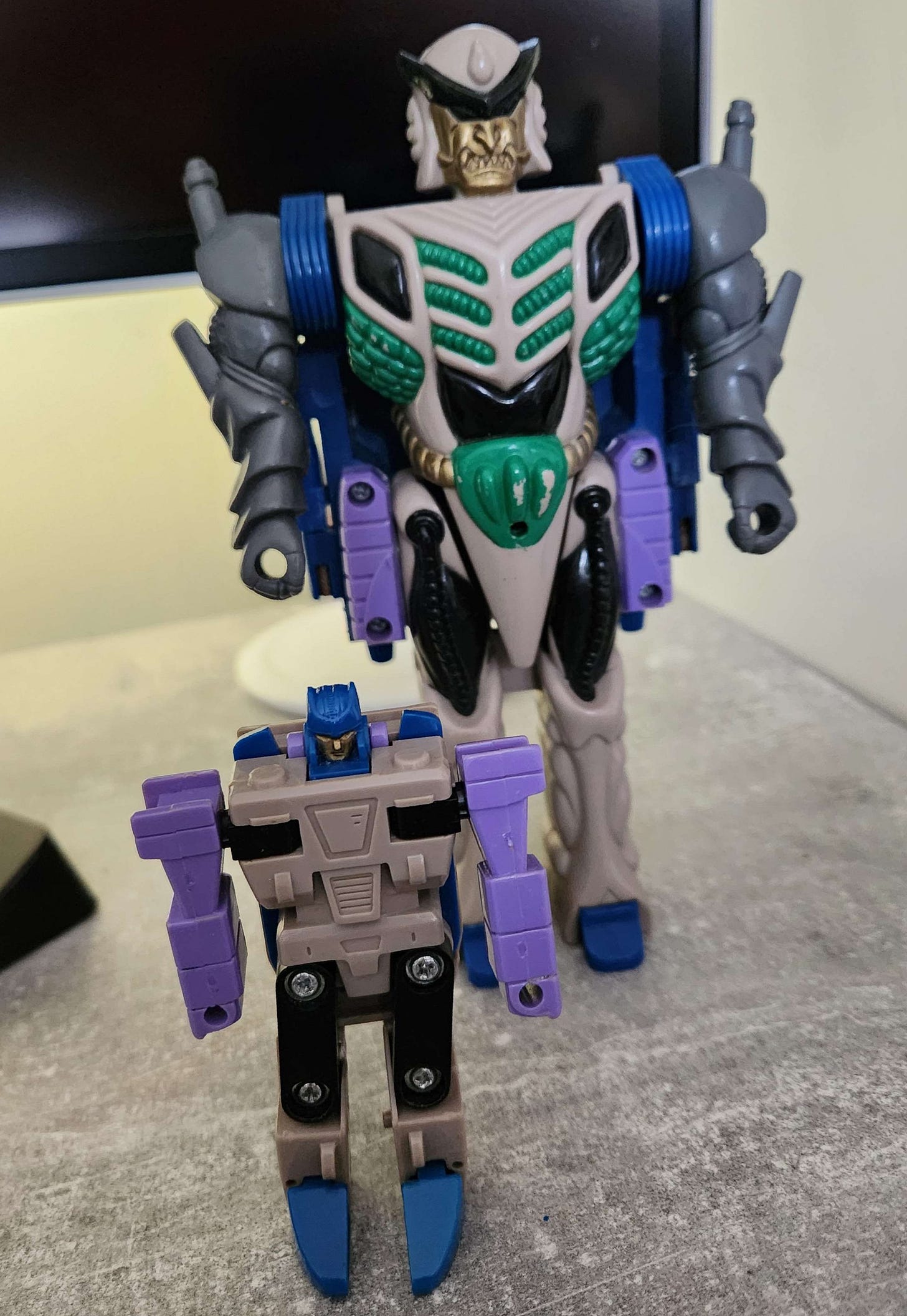

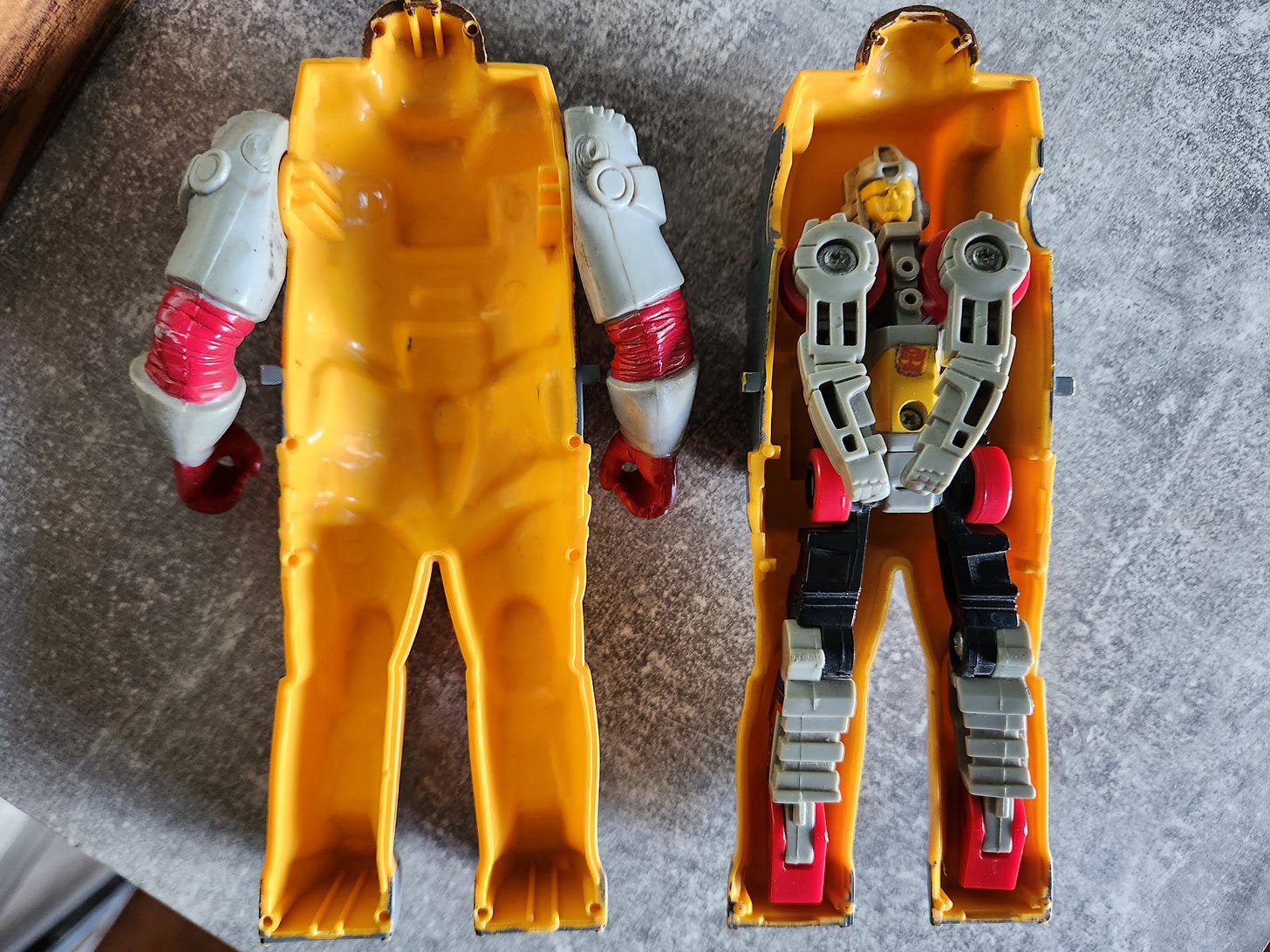

Presumably around 1988 I won a couple of Pretenders in a competition (probably run by Woolworths or similar). Try as I might they always seemed a bit....off.
That said (and as usual), the comic did all sorts of interesting things with them. Thunderwing in particular was turned into a very compelling character - although, notably, I don't think I ever realised he was a Pretender? He was just a cool jet who got obsessed with the Matrix.
(the bit where Thunderwing attempts to defeat Unicron in the final issues, and Unicron points out that he's corrupted the Matrix to the point of it being useless....so good)
Definitely a case of an interesting idea, but with badly fumbled execution.
One bit I never could understand, even as a kid and even taking into consideration the many mysterious scale issues around Transformers, was whether the human-like Pretender shells were supposed to be human-sized, or Transformer sized.
Apparently I'm still thinking about this age 44, which is alarming.
When you pleasure yourself with Vroom do you attach the sidecar or not?